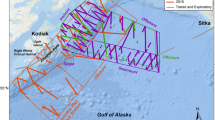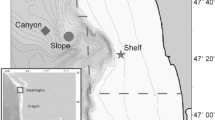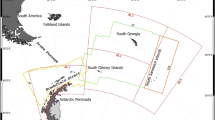Abstract
Two wind energy areas (WEAs), designated by the Bureau of Ocean Energy Management, offshore of Massachusetts and Rhode Island were surveyed between October 2011 and June 2015. A total of 969 cetacean sightings of over 10,000 animals were documented during systematic line-transect aerial surveys (67,525 km flown). Twelve cetacean species were documented, including seven odontocete and five mysticete species. Cetaceans were recorded in all seasons demonstrating inter-annual, seasonal, and spatial use of the WEAs. Peak presence occurred in the spring and summer for most species, with the exception of North Atlantic right whales, which occurred primarily in the winter and spring. Right and sei whales were documented regularly throughout the study and in higher numbers than expected. Seasonal estimates of abundance were calculated for seven species, including five baleen whales (fin, minke, humpback, right, and sei) and two dolphins (common and bottlenose). The results suggest the area is a previously underestimated seasonal habitat for cetaceans including several endangered baleen whale species. These data will help inform mitigation strategies for future wind energy development. Climate change effects, increased coastal urbanization, and other factors argue for continued monitoring of cetaceans in the WEAs offshore of New England.








Similar content being viewed by others
References
Allen GM (1916) The whalebone whales of New England. Memoirs of the Boston Society of Natural History 8:107–322; plates 8–16
Bailey H, Brookes K, Thompson P (2014) Assessing environmental impacts of offshore wind farms: Lessons learned and recommendations for the future. Aquat Biosyst 10:8–13
Bergström L, Kautsky L, Malm T, Rosenberg R, Wahlberg M, Capetillo NÅ, Wilhelmsson D (2014) Effects of offshore wind farms on marine wildlife—a generalized impact assessment. Environ Res Lett 9:1–12
Bester M (2014) Marine mammals – natural and anthropogenic influences. Glob Environ Chang 1:167–174
BOEM Bureau of Ocean Energy Management (2013) Commercial wind lease issuance and site assessment activities on the Atlantic outer continental shelf offshore Rhode Island and Massachusetts. Revised environmental assessment, OCS EIS/EA BOEM 2013–1131. Bureau of Ocean Energy Management, Washington, D.C., pp 417. www.boem.gov/uploadedFiles/BOEM/Renewable_Energy_Program/State_Activities/BOEM%20RI_MA_Revised%20EA_22May2013.pdf
BOEM Bureau of Ocean Energy Management (2014) Commercial wind lease issuance and site assessment activities on the Atlantic outer continental shelf offshore Massachusetts. Revised environmental assessment, OCS EIS/EA BOEM 2014–603. Bureau of Ocean Energy Management, Washington, D.C., p 674. www.boem.gov/uploadedFiles/BOEM/Renewable_Energy_Program/State_Activities/BOEM%20RI_MA_Revised%20EA_22May2013.pdf
Bonar PA, Bryden IG, Borthwick AG (2015) Social and ecological impacts of marine energy development. Renew Sust Energ Rev 47:486–495
Breton SP, Moe G (2009) Status, plans and technologies for offshore wind turbines in Europe and North America. Renew Energy 34:646–654
Brown MW, Kraus SD, Slay CK, Garrison LP (2007) Surveying for discovery, science, and management. In: Kraus SD, Rolland RM (eds) The urban whale: North Atlantic right whales at the crossroads. Harvard University Press, Cambridge, pp 105–137
Buckland ST, Anderson DR, Burnham KP, Laake JL (1993) Distance sampling: estimating abundance of biological populations. Chapman and Hall, London
Buckland ST, Anderson DR, Burnham KP, Laake JL, Borchers DL, Thomas L (2001) Introduction to distance sampling: estimating abundance of biological populations. Oxford University Press, New York
Burnham KP, Anderson DR, Laake JL (1985) Efficiency and bias in strip and line transect sampling. J Wildl Manag 49:1012–1018
Carstensen J, Henriksen O, Teilmann J (2006) Impacts of offshore wind farm construction on harbour porpoises: acoustic monitoring of echolocation activity using porpoise detectors (T-PODs). Mar Ecol Prog Ser 321:295–308
CETAP Cetacean and Turtle Assessment Program (1982) A characterization of marine mammals and turtles in the Mid- and North Atlantic areas of the U.S. Outer Continental Shelf. Final report, contract AA551-CT8–48, for the US Bureau of Land Management, Washington, DC. CETAP, University of Rhode Island, Kingston, p 586
Clapham P, Young S, Brownell R (1999) Baleen whales: conservation issues and the status of the most endangered populations. Mammal Rev 29:37–62
Clark CW, Ellison WT, Southall BL, Hatch L, Van Parijs SM, Frankel A, Ponirakis D (2009) Acoustic masking in marine ecosystems: intuitions, analysis, and implication. Mar Ecol Prog Ser 395:201–222
Copping A, Breithaupt S, Whiting J, Grear M, Tagestad J, Shelton G (2015) Likelihood of a marine vessel accident from wind energy development in the Atlantic. Wind Energy 19(9):1557–1566
Croll DA, Tershy BR, Hewitt RP et al (1998) An integrated approch to the foraging ecology of marine birds and mammals. Deep-Sea Res II Top Stud Oceanogr 45:1353–1371
Dähne M, Gilles A, Lucke K et al (2013) Effects of pile-driving on harbour porpoises (Phocoena phocoena) at the first offshore wind farm in Germany. Environ Res Lett 8:1–16
Doucette GJ, Christina MM, Kristen LK et al (2012) Endangered North Atlantic right whales (Eubalaena glacialis) experience repeated, concurrent exposure to multiple environmental neurotoxins produced by marine algae. Environ Res 112:67–76
Eberhardt LL, Chapman DG, Gilbert JR (1979) A review of marine mammal census methods. Wildl Monogr 63:1–46
Esteban MD, Diez JJ, López JS, Negro V (2011) Why offshore wind energy? Renew Energy 36:444–450
Gates CE (1979) Line transect and related issues. In: Cormack RM, Patil GP, Robson DS (eds) Sampling biological populations. International Cooperative Publishing House, Fairland, pp 71–154
Hamilton B, Bielecki M, Bloch C et al (2014) Offshore wind market and economic analysis. 2014 annual market assessment. Technical Report DE-EE0005360. Prepared for the U.S. Department of Energy. Navigant Consulting, Burlington, p 183. http://energy.gov/sites/prod/files/2014/09/f18/2014%20Navigant%20Offshore%20Wind%20Market%20%26%20Economic%20Analysis.pdf
Hare, J.A., W.E. Morrison, M.W. Nelson, et al. 2016. A vulnerability assessment of fish and invertebrates to climate change on the northeast U.S. continental shelf. PLoS ONE 11:e0146756, 30
Hastie GD, Wilson B, Wilson LJ, Parsons KM (2004) Functional mechanisms underlying cetacean distribution patterns: hotspots for bottlenose dolphins are linked to foraging. Mar Biol 144:397–403
Hatch L, Clark CW, Merrick R et al (2008) Characterizing the relative contributions of large vessels to total ocean noise fields: a case study using the Gerry E. Studds Stellwagen Bank National Marine Sanctuary. Environ Manag 42:735–752
Kaldellis JK, Kapsali M (2013) Shifting towards offshore wind energy—recent activity and future development. Energy Policy 53:136–148
Kenney RD (2011) The North Atlantic right whale Consortium database: a guide for users and contributors. North Atlantic right whale Consortium reference document 2010–01. University of Rhode Island, Graduate School of Oceanography, Narragansett, p 141. http://www.narwc.org/pdf/SightingsDatabaseUsers%20Guide%20(working-2014).pdf
Kenney RD, Vigness-Raposa KJ (2010) Marine mammals and sea turtles of Narragansett Bay, Block Island sound, Rhode Island sound, and nearby waters: an analysis of existing data for the Rhode Island Ocean special area management plan. Technical report no. 10. Coastal Resources Management Council, Wakefield, p 337. http://seagrant.gso.uri.edu/oceansamp/pdf/appendix/10-Kenney-MM&T.pdf
Kenney RD, Winn HE (1986) Cetacean high-use habitats of the northeast United States continental shelf. Fish Bull 84:345357
Kenney RD, Wishner KF (1995) The South Channel ocean productivity EXperiment. Cont Shelf Res 15:373–384
Kenney RD, Hyman MAM, Owen RE, Scott GP, Winn HE (1986) Estimation of prey densities required by western North Atlantic right whales. Mar Mamm Sci 2:1–3
Kraus SD, Rolland RM (2007) The urban whale syndrome. In: Kraus SD, Rolland RM (eds) The urban whale: North Atlantic right whales at the crossroads. Harvard University Press, Cambridge, pp 488–513
Laake JL, Buckland ST, Anderson DR, Burnham KP (1993) DISTANCE users guide. Chapman and Hall, London
LaBrecque E, Curtice C, Harrison J, Van Parijs SM, Halpin PN (2015) Biologically important areas for cetaceans within US waters-East Coast region. Aquat Mamm 41:17–29
Leiter SM, Stone KM, Thompson JL et al (2017) North Atlantic right whale Eubalaena glacialis occurrence in offshore wind energy areas near Massachusetts and Rhode Island. Endanger Species Res (in press)
Madsen PT, Wahlberg M, Tougaard J, Lucke K, Tyack P (2006) Wind turbine underwater noise and marine mammals: implications of current knowledge and data needs. Mar Ecol Prog Ser 309:270–295
Mann J, Teilmann J (2013) Environmental impact of wind energy. Environ Res Lett 8(3):035001
Mbugua S (1996) Counting elephants from the air—sample counts. In: Kangwana K (ed) Studying elephants. African Wildlife Foundation, Nairobi, pp 21–27
Nedwell J, Howell D (2006) A review of offshore windfarm related underwater noise sources. Technical report 544R0308. Submitted to Collaborative offshore wind energy research into the environment [COWRIE]. Subacoustech Ltd., Hampshire, p 63 http://www.subacoustech.com/wp-content/uploads/544R0308.pdf
Parks SE, Clark CW (2007) Acoustic communication: social sounds and the potential impacts of noise. In: Kraus SD, Rollandeds RM (eds) The urban whale: North Atlantic right whales at the crossroads. Harvard University Press, Cambridge, pp 310–332
Piatt JF, Methven DA (1992) Threshold foraging behavior of baleen whales. Mar Ecol Prog Ser 84:205–210
Reeves RR, Mead JG, Katona S (1978) The right whale, Eubalaena glacialis, in the western North Atlantic. Rep Int Whal Comm 28:303–312
Ridgway MS (2010) Line transect distance sampling in aerial surveys for double-crested cormorants in coastal regions of Lake Huron. J Great Lakes Res 36:403–410
Rodrigues S, Restrepo C, Kontos E, Pinto RT, Bauer P (2015) Trends of offshore wind projects. Renew Sust Energ Rev 49:1114–1135
Rolland RM, Hunt KE, Doucette GJ, Rickard LG, Wassner SK (2007) The inner whale: hormones, biotoxins, and parasites. In: Kraus SD, Rolland RM (eds) The urban whale: North Atlantic right whales at the crossroads. Harvard University Press, Cambridge, pp 232–272
Rolland RM, Parks SE, Hunt KE et al (2012) Evidence that ship strikes increases stress in right whales. Proceedings of the Royal Society Biological Sciences 279:2363–2368
Rolland RM, Schick RS, Pettis HM, Knowlton AR, Hamilton PK, Clark JS, Kraus SD (2016) Health of North Atlantic right whales, Eubalaena glacialis, over three decades: from individual health to demographic and population health trends. Mar Ecol Prog Ser 542:265–282
Roman J, McCarthy J (2010) The whale pump: marine mammals enhance primary productivity in a coastal basin. PLoS One 5(e13255):8
Russell DJF, Hastie GD, Thompson D et al (2016) Avoidance of wind farms by harbor seals is limited to pile driving activities. J Appl Ecol 54:1–11
Scott TM, Sadove SS (1997) Sperm whale, Physeter macrocephalus, sightings in shallow shelf waters off Long Island, New York. Mar Mamm Sci 13:317–321
Seber GAF (1982) The estimation of animal abundance and related parameters, second edn. C. Griffin & Co., Ltd., London
Taylor JKD, Kenney RD, Leroi DR, Kraus SD (2014) Automated vertical photography for detecting pelagic species in multitaxon aerial surveys. Mar Technol Soc J 48:36–48
Teilmann J, Carstensen J (2012) Negative long term effects on harbour porpoises from a large scale offshore wind farm in the Baltic—evidence of slow recovery. Environ Res Lett 7:1–10
Thomas L, Buckland ST, Rexstad E et al (2010) Distance software: design and analysis of distance sampling surveys for estimating population size. J Appl Ecol 47:5–14
Tielens J, Estabrook B, Rahaman A, Clark CW, Rice AN (2017) Occurrence patterns of five baleen whale species in the Nantucket shelf area. Divers Distrib (in press)
Waring GT, Josephson E, Maze-Foley K, Rosel PE (2015) US Atlantic and Gulf of Mexico marine mammal stock assessments--2014. NOAA Technical Memorandum NMFS NE-231, p 361. http://www.nefsc.noaa.gov/publications/tm/tm231/tm231.pdf
Weilgart L (2007) A brief review of known effects of noise on marine mammals. Int J Comp Psychol 20:159–168
Williams TM, Haun J, Davis RW, Fuiman LA, Kohin S (2001) A killer appetite: metabolic consequences of carnivory in marine mammals. Comp Biochem Physiol Part A 129:785–796
Williams R, Wright AJ, Ashe E et al (2015) Impacts of anthropogenic noise on marine life: publication patterns, new discoveries, and future directions in research and management. Ocean Coast Manag 115:17–24
Wisniewska DM, Johnson M, Teilman J et al (2016) Ultra-high foraging rates of harbor porpoise make them vulnerable to anthropogenic disturbances. Curr Biol 26:1–6
Acknowledgements
The Massachusetts Clean Energy Center and the Bureau of Ocean Energy Management supported this study under Cooperative Agreement number M12 AC00. Scientists and observers who participated in this work include J. Taylor, T. Montgomery, O. O’Brien, M. Hagbloom, R. Lynch, and L. Crowe, J. Thompson, S. Leiter, and K. Stone. We thank them all for their contributions to data collection and data processing. We are grateful to our collaborators at the Cornell Lab of Ornithology, including C. Clark, A. Rice, B. Estabrook and J. Tielens. These surveys would not have been possible without the extraordinary efforts of EnviroEye LLC (formerly ASSIST Aviation Solutions LLC), particularly pilots Aiden Seltsam-Wilps, Keith Lapierre, Don Turner, and Dan Fields.
Author information
Authors and Affiliations
Corresponding author
Rights and permissions
About this article
Cite this article
Stone, K.M., Leiter, S.M., Kenney, R.D. et al. Distribution and abundance of cetaceans in a wind energy development area offshore of Massachusetts and Rhode Island. J Coast Conserv 21, 527–543 (2017). https://doi.org/10.1007/s11852-017-0526-4
Received:
Revised:
Accepted:
Published:
Issue Date:
DOI: https://doi.org/10.1007/s11852-017-0526-4




